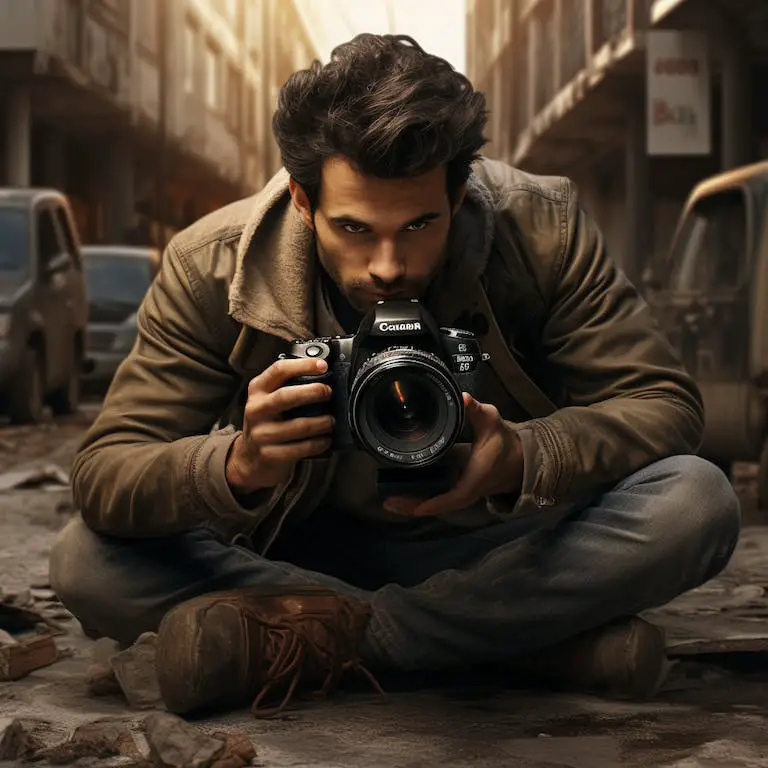If you have a passion for capturing the essence of individuals and telling their unique stories through images, you’re in the right place. Starting a successful portrait photography business can be a rewarding journey, but it’s essential to navigate the initial steps with clarity and purpose.
In this blog post, we’ll guide you through the basics of launching your own portrait photography business, breaking down the process into manageable steps. Whether you’re an aspiring photographer or someone looking to turn your hobby into a profession, we’ve got you covered.
From setting up your studio to mastering the art of client communication, we’ll share practical tips and insights to help you kickstart your venture.
Get ready to unleash your creativity, connect with clients, and build a thriving business doing what you love. Let’s dive in and explore the key elements that will set you on the path to a successful portrait photography career!
Contents
- 1 Invest in Quality Gear for Your Portrait Photography
- 2 Understand the Basics of Photography
- 3 Set Prices for Your Photography Services
- 4 Craft a Professional Portrait Photography Portfolio
- 5 The Importance of Client Relationships
- 6 Utilize Social Media for Your Portrait Photography Business
- 7 Conclusion:
- 8 FAQs
- 8.1 Do I need formal education in photography to start a portrait photography business?
- 8.2 How do I determine my pricing for portrait photography services?
- 8.3 Should I specialize in a specific type of portrait photography, like family portraits or headshots?
- 8.4 What equipment do I need to start a portrait photography business?
- 8.5 How do I find clients for my portrait photography business?
- 8.6 Should I rent a studio space or work on-location for portrait sessions?
- 8.7 What legal considerations should I be aware of when starting a photography business?
Invest in Quality Gear for Your Portrait Photography
If you’re serious about starting a portrait photography business, then you need to invest in quality gear. This doesn’t mean that you need the most expensive equipment on the market, but it does mean investing in gear that will help you produce the best possible results for your clients. Below is a list of essential gear for portrait photographers, along with a few tips on how to choose the right gear for your needs:
1. Camera body – The most important piece of equipment for any photographer is the camera body. For portrait photography, you’ll want a camera with a full-frame sensor, which will give you the best image quality and low-light performance. There are a number of great camera bodies on the market, so choose one that fits your budget and your shooting style.
2. Lenses – In addition to a quality camera body, you’ll also need a few good lenses for portrait photography. A 50mm prime lens is a great all-purpose lens for portraits, while a 85mm prime lens is ideal for headshots. If you want to get creative with your portraits, consider a wide-angle lens or a telephoto lens.
3. Lighting – Lighting is essential for portrait photography, so you’ll need to invest in a good lighting setup. A basic lighting kit for portrait photography should include two or three lights, stands, softboxes, and umbrellas.
4. Tripod – A tripod is an important piece of equipment for any photographer, but it’s especially important for portrait photographers. A tripod will allow you to use long exposures and capture sharp images, even in low-light conditions.
5. Editing software – After you’ve taken your portraits, you’ll need to edit them to perfection. For this, you’ll need a good photo editing software like Adobe Photoshop or Lightroom.
Investing in quality gear is essential for any portrait photographer. By investing in the right gear, you’ll be able to take better photos and provide your clients with the high-quality results they’re looking for.

Understand the Basics of Photography
Are you thinking about starting a portrait photography business? If so, it’s important to understand the basics of photography. Here are a few things you need to know:
1. Camera Settings: You need to know how to adjust the aperture, shutter speed, and ISO on your camera. These settings will affect the exposure of your images.
2. Lighting: Good lighting is essential for great portraits. You need to know how to use natural light, artificial light, and flash photography.
3. Posing: You need to be able to pose your subjects in a way that is flattering and makes them look their best.
4. Editing: Basic editing skills are important for creating beautiful portraits. You should learn how to use photo editing software like Photoshop or Lightroom.
5. Business Basics: If you want to start a portrait photography business, you need to understand the basics of running a business. This includes marketing, accounting, and customer service.
If you take the time to learn the basics of photography, you’ll be well on your way to starting a successful portrait photography business.
Set Prices for Your Photography Services
As with any business, one of the first things you need to do when starting your own portrait photography business is to set your prices. This can be a tricky task, as you need to find a balance between what you need to charge to make a profit and what your clients are willing to pay.
But with a little research and careful planning, you can come up with a pricing structure that works for both you and your clients.
To start, take a look at your costs. This includes things like your equipment, software, props, and other supplies. Once you have a good idea of your overhead costs, you can start to think about how much you need to charge for your services.
Next, research the going rates for portrait photography in your area. This will give you a good starting point for setting your own prices. Be sure to factor in your unique style and approach when coming up with your rates.
Once you have an idea of what you need to charge, it’s time to start thinking about your clients. What are their budgets? What are their needs? What are they looking for in a portrait photographer? By understanding your target clientele, you can better tailor your pricing to fit their needs.
Remember, your prices don’t have to be set in stone. You can always adjust them as you go along and as your business grows. The important thing is to get started and to keep pushing forward. With a little effort, you can build a successful portrait photography business that meets the needs of both you and your clients.

Craft a Professional Portrait Photography Portfolio
As a portrait photographer, your portfolio is your best marketing tool. It is essential to have a strong portfolio that reflects your unique style and ability to capture the essence of your subjects. Here are some tips to help you craft a professional portfolio that will showcase your talents and attract clients.
1. Start with your best work.
When selecting images for your portfolio, it is important to choose your best work. This will give potential clients a good idea of your skill level and what they can expect if they hire you. Start with your strongest images and then fill in with other shots that you are proud of.
2. Organize your portfolio.
Your portfolio should be organized in a way that is easy to navigate and makes sense. One way to do this is to arrange your images by theme or subject matter. For example, you might have a section for family portraits, another for headshots, and another for wedding photography. This will help potential clients quickly find the type of photography they are interested in.
3. Keep it fresh.
Your portfolio should be a reflection of your current work, so be sure to update it regularly. Every time you shoot something new, add the best images to your portfolio. This will keep your portfolio current and give potential clients a true representation of your skill as a photographer.
4. Make it personal.
Your portfolio should reflect your unique style and personality. This is what will set you apart from other photographers and attract clients who are looking for someone with your particular vision. Choose images that reflect your aesthetic and show off your creative eye.
5. Choose quality over quantity.
It is better to have a small portfolio of strong images than a large portfolio of average ones. When choosing which images to include, be selective and only include those that you are confident in. This will give you a much stronger portfolio overall.
By following these tips, you can craft a professional portrait photography portfolio that will showcase your talents and attract clients. Remember to start with your best work, keep it fresh, and make it personal to give potential clients a true sense of who you are as a photographer.

The Importance of Client Relationships
As a photographer, one of the most important aspects of your business will be the relationships that you form with your clients. These relationships can make or break your business, so it’s important to take the time to nurture them.
There are a few key things to remember when it comes to client relationships:
1. COMMUNICATION IS KEY
This is probably the most important point to remember. Good communication is the foundation of any strong relationship, and that’s especially true when it comes to business relationships.
Make sure you’re always clear and concise in your communications with clients, and take the time to really listen to what they have to say. This will help build trust and respect, and will make it easier to work together towards a common goal.
2. UNDERPROMISE AND OVERDELIVER
In business, as in life, it’s always better to underpromise and overdeliver. If you set expectations that are too high, you’re setting yourself up for disappointment – and your clients will likely be disappointed too.
It’s better to be realistic in your expectations, and then exceed those expectations whenever possible. Your clients will be impressed and will appreciate your attention to detail.
3. BE RESPECTFUL OF YOUR CLIENT’S TIME
Nobody likes to feel like they’re being ignored, and that’s especially true of your clients. Make sure you’re respectful of your client’s time, and don’t keep them waiting unnecessarily.
If you need to reschedule an appointment or call, make sure you give plenty of notice. And if you say you’re going to do something, make sure you follow through in a timely manner.
4. SHOW YOUR APPRECIATION
Your clients are the lifeblood of your business, so make sure you show them your appreciation. Whether it’s a handwritten thank-you note after a shoot, or a small gift on their birthday, take the time to let your clients know how much you appreciate their business.
5. BE FLEXIBLE
No two clients are alike, and no two shoots are alike. Be flexible in your approach, and be willing to change your plans on the fly if necessary. Your clients will appreciate your flexibility, and it will help build a stronger relationship.
These are just a few of the many things to keep in mind when it comes to client relationships. By following these tips, you’ll be well on your way to building strong, lasting relationships with your clients – which is essential for any successful photography business.
Utilize Social Media for Your Portrait Photography Business
As a portrait photographer, one of the best ways to get your name out there and to attract new clients is to utilize social media. Platforms like Facebook, Instagram, and Twitter are great ways to show off your work, connect with potential clients, and build up your brand.
Here are some tips on how to use social media to grow your portrait photography business:
1. Post great photos: This may seem like a no-brainer, but it’s important to regularly post high-quality images on your social media accounts. Potential clients will be looking at your photos to gauge your skill level, so make sure you’re putting your best work forward.
2. Use hashtags: Hashtags are a great way to reach new people and get your work seen by people who might not otherwise come across it. When posting photos on Instagram, be sure to use relevant hashtags so that your photos show up when people search for those topics.
3. Engage with others: Social media is about more than just posting your own content – it’s also about interacting with others. Comment on other people’s photos, start conversations, and join in on existing conversations. The more you engage with others, the more likely they are to remember you and your business.
4. Offer specials and discounts: Everyone loves a good deal, so offer specials and discounts exclusively for your social media followers. This is a great way to encourage people to follow you and to get them interested in your work.
5. Run social media contests: Contests are a great way to engage with your followers and to get people excited about your work. You can run a contest where people have to share one of your photos and use a specific hashtag, or you can ask people to submit their own photos for a chance to win a prize.
By following these tips, you can use social media to grow your portrait photography business and to attract new clients.

Conclusion:
In conclusion, if you’re thinking about starting a portrait photography business, there are a few key things to keep in mind. First, you need to be passionate about photography and have a strong portfolio to show potential clients.
Secondly, you need to be organized and have a clear business plan. Finally, make sure you market yourself well and build a strong online presence. By following these tips, you’ll be well on your way to starting a successful portrait photography business.
I hope this article has given you some helpful tips on how to start a portrait photography business. If you have any questions, please feel free to leave a comment below and I’ll be happy to answer them.
FAQs
Do I need formal education in photography to start a portrait photography business?
While formal education can be beneficial, it’s not mandatory. Focus on developing your skills through hands-on experience, workshops, and online resources.
How do I determine my pricing for portrait photography services?
Consider factors like your skill level, local market rates, equipment costs, and the time involved in each session. Research competitors in your area to set competitive yet fair prices.
Should I specialize in a specific type of portrait photography, like family portraits or headshots?
Specializing can help you target a specific audience, but it’s not necessary. Experiment with different styles initially and then decide based on your passion and market demand.
What equipment do I need to start a portrait photography business?
At a minimum, invest in a good camera, lenses, lighting equipment, and a sturdy tripod. As your business grows, you can expand your gear.
How do I find clients for my portrait photography business?
Utilize social media, create a portfolio website, network with local businesses, and ask satisfied clients for referrals. Building a strong online presence is key.
Should I rent a studio space or work on-location for portrait sessions?
Initially, consider on-location shoots to minimize costs. As your business grows, you can explore renting a studio for more control over the shooting environment.
What legal considerations should I be aware of when starting a photography business?
Ensure you have the necessary permits, understand copyright laws, and have clients sign contracts outlining the terms of your services to protect both parties.







